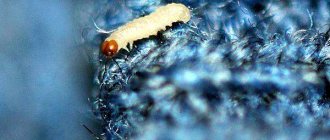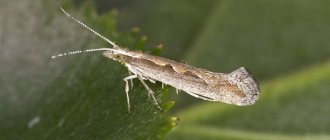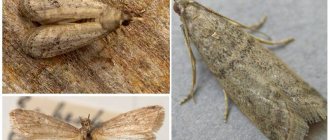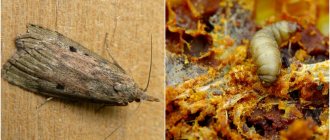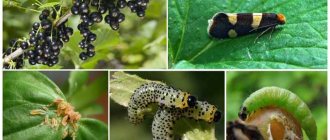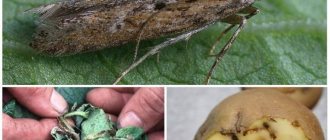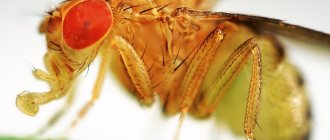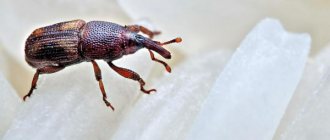In total, there are about 3,000 species of moths in the world, of which approximately 30 are pests. 14 of them live in human homes. To the unenlightened eye they are all similar. However, a professional will immediately find differences in the body structure and color of the wings of butterflies. There are two main groups - food moth and house moth. Food moths are called some types of moths that feed on grocery products - cereals, flour, pasta, confectionery, dried fruits.
What does the house moth, or as it is also called, duffel moth, eat? As the name suggests, she prefers wearable items. Moreover, it uses exclusively natural materials, although in principle it can also damage synthetic fabrics in which a woolen blouse or felt boots are wrapped.
Why are moths dangerous to humans?
It is believed that this insect does not pose an immediate danger to the human body. The larva cannot bite through the skin: it is too thick for it, and the adult has no oral apparatus at all.
However, in rare cases, allergies to provoking substances occur - chitin or arthropodine, which are contained in scales and hairs on the insect's body.
The disease develops only in cases where a person comes into contact with a large concentration of allergens. Employees of grocery warehouses or woolen products manufacturing plants are at risk of developing a rare type of allergy if there are insect pests there.
Sometimes allergies are triggered by wax moths that live in beehives. From moth larvae, traditional healers prepare remedies in which arthropodine is present in high concentrations.
Cases of an allergic reaction to house moths have not been recorded, since insects do not live in such large numbers in the house.
Moths can cause significant material damage if larvae are found in a wardrobe or kitchen. And this is already a reason for grief, and sometimes nervous breakdown.
Food pest and fur coat
Having noticed a food pest in the house, responsible housewives begin to worry about the safety of not only food, but also items of clothing. But not all people take into account that the oral apparatus of this species of moth is less developed, so it is not capable of damaging the dense fibers of cashmere products or pile. Its larvae secrete enzymes that disrupt the integrity of plant foods. Leather and fibers are those products that are unattractive to the moth.
A different type takes up residence in wardrobes and wardrobes – clothing. This moth eats woolen clothes, cashmere, silk and fur items. It is not possible to protect viscose and cotton fabric from this pest. Clothes parasites are attracted to things and products for the manufacture of which natural raw materials are used. For example, the larvae will not ignore a woolen sweater or natural carpeting.
Pests use synthetics provided that they contain natural fibers. To get to the treat, caterpillars gnaw through paper, plastic or acrylic film. Therefore, it is impossible to preserve things using such packaging.
Cotton moth
Some people are interested in whether cotton moth exists in our country. After all, these small insects can cause serious damage not only to an ordinary person, but also to an entire enterprise. Cases have been recorded of pests destroying long-staple and other types of cotton plantations.
At the initial stages, it is difficult to identify how the larva eats raw materials and vegetation. At the same time, the parasite spreads quite quickly, which complicates the control process. Particularly resistant caterpillars penetrate the storage facility and wait out the winter in the seed material. To eliminate large populations of insects that breed in such premises, special chemicals are required.
Do moths eat and what do they eat?
The life cycle of an insect includes 4 stages. Passing through each of them, it changes radically. A larva (caterpillar) hatches from the egg, which turns first into a pupa, and then into a sexually mature individual - an adult.
The caterpillars actively feed and build a spindle-shaped cocoon from suitable surrounding material. During this period they cause the greatest harm to humans.
Moth in the cereal.
During its existence (from several days to a month), the butterfly moth does not eat anything, it only uses accumulated reserves. Her jaws, proboscis and digestive organs are not developed. The main task of the imago is to leave offspring, i.e. lay eggs. Under natural conditions, food for insects includes seeds and berries of plants, grain, nuts, fallen bird feathers and animal fur.
Penetrating into a house, moths will always find something to profit from, especially since in the apartment the conditions for living and breeding of the pest are optimal.
What do food moths like in the kitchen?
Contamination of food in the house most often occurs after a bag of low-quality cereals or flour enters the kitchen. Actively reproducing, insects settle on shelves and cabinets with supplies.
Each moth species prefers its own food source. Fruit moths can often be found in dried fruits, grain moths - in buckwheat, pearl barley or semolina. But given the opportunity, a representative of any variety of food moth will not refuse to eat other suitable food.
Larvae or traces of their vital activity can be found in various products:
- flour and flour baked goods;
- cereals and whole grains;
- pasta;
- dried fruits, seeds and nuts;
- chocolates and other sweets.
Caterpillars easily move from one bag to another, gnawing through paper or polyethylene. Butterflies scatter throughout the kitchen and lay eggs even in hard-to-reach places. The only obstacle can be glass or ceramic dishes with a tightly sealed lid.
Food moth.
What do clothes moths eat in the apartment?
Another variety is the clothing (clothes) moth. A pest butterfly can fly into an apartment and lay eggs in the closet. Store-bought items may be contaminated with larvae or pupae. Sometimes insects enter the house along with pets. The following are at risk:
- items made of pure wool and fabrics with added wool fiber;
- products made from natural fur (fur coats, hats, sheepskin coats);
- woolen, half-woolen carpets and furniture upholstery;
- shoes with natural insulation - fur or wool;
- cotton and blended fabrics;
- animal bristles and bird feathers.
Clothes moth caterpillars gnaw through fabric or knitwear if they contain even a small percentage of wool or cotton. Sometimes the larvae damage purely synthetic fabrics if they lie next to natural ones.
Prevention
To prevent the parasite from infesting walnuts or damaging your coat, fur coat hair, or books, it is necessary to carry out preventive measures at regular intervals.
- Next to window openings and ventilation ducts, where the parasite comes from, bags filled with aromatic and natural plants are placed. For food and clothes moths, the odor emitted by geranium or wormwood is unpleasant.
- Peels of lemon and other citrus fruits are suitable for repelling. Since the strong aroma comes from fresh peels, they should be changed periodically.
- A solution containing vinegar or aromatic composition is used to clean kitchen units, cabinets and tables.
- Lavender extract, orange or grapefruit essential oil are suitable for repelling.
- Many people have seen how a moth eats a piece of fur. Therefore, in wardrobes where fur coats or cashmere coats are stored, aromatic herbs and fumigators should be placed.
Carrying out preventive measures is much easier than actively combating spreading pests.
How to prevent moths and protect food
It will be quite difficult to prevent the appearance because it is hardly possible to close all the vents, cracks, and make impenetrable door and window openings through which food moths enter the room. But it is quite possible to protect the foods that insects most often eat.
Naturally, a dirty kitchen full of specific odors attracts insects the most. You need to keep this room clean. Store products in sealed bags, jars and containers. It is worth periodically treating kitchen cabinets with disinfectants and putting repellents with food:
- mint;
- orange;
- lavender;
- black pepper.
How moths harm clothes
There are known facts that moths even attack synthetic clothing. Before considering this nonsense, you should first carefully study the composition of the synthetics themselves.
Even a moth will not eat pure synthetics - the larvae are not able to digest nylon or, for example, polypropylene fibers. However, if the thing is made from a mixture of synthetic and natural materials (which are still popularly called “synthetics”), the larva will be quite content with the nutrients from such a product.
This is interesting
Some synthetic materials are not digested in the caterpillar's stomach, but safely pass through the digestive tract. The more synthetics in the tissue eaten by the caterpillar, the less nutrients the larva itself receives, the slower it grows. Accordingly, on modern “bread” the development cycle of moths, even under optimal temperature conditions, can last almost six months.
Review
“What can we do with this crap? There was a natural wool sweater hanging on the trempel, knitted by hand - but no, the moth had completely destroyed the “Sport” cockerel hat, which was completely synthetic.”
Oleg, Kurgan
The moth larva, emerging from the egg, does not particularly strive to move away from the place of appearance. Usually it eats away as much tissue or fur around itself as possible, molts several times and pupates here. The cover around her body, especially dense, is even more conducive to this lifestyle.
It is also useful to read: Using bee moth tincture to treat diseases
But sometimes caterpillars, especially young ones, move within the closet over distances quite large for themselves, moving from newly acquired things to those that have already managed to hang. Therefore, it is necessary to destroy the moth either on the approaches to the closet, or at the first signs of its appearance.
What do clothes moths eat in the apartment?
The clothes moth's favorite treat is things made of natural fabric, especially wool and fur. And also such moths can ruin cotton items. At the same time, cleanliness of clothes does not affect the moth’s appetite in any way.
This type of moth enters the apartment in the following ways:
- with contaminated things;
- with pets.
Moth larvae and pupae mainly enter the apartment along with recently purchased items. Even if you buy clothes from prestigious fashion stores, it is possible that moths will not come with them. Having flown into an apartment, clothes moths immediately begin to breed and render furniture upholstery, carpets and various fur and wool items unusable.
The clothes moth is one of the types of moths that do not have a developed digestive tract and oral cavity, so only its larvae can spoil things, and an adult butterfly does not feed on anything, it can only lay eggs. Clothes moth larvae eat things in the area where they hatch from the eggs.
What to eat in the apartment
What do moths eat in a residential apartment? She primarily follows her diet and can eat both clothes and food. It depends on the type of parasite. The food species loves all bulk products, while the clothing species lives on natural fabrics.
There are no strict restrictions in the class, therefore, having destroyed one type of tissue or cereal, the parasite is mistaken for another.
Favorable apartment conditions allow insects to actively develop and reproduce. Therefore, moths strive to get into the living space from the external environment and can even enter through a window.
Diet
What does a moth eat? It is worth distinguishing two food groups. The first includes direct food at home. The second includes natural products. The clothes parasite lays eggs in the nests of birds and rodents.
The larvae feed on fur or feathers shed by birds and animals. Under such conditions, their life cycle can significantly increase, since due to the lack of favorable conditions, the parasites have to overwinter in the form of pupae.
In the wild, food moths love nuts and seeds. Usually the parasite finds them in the clutches of forest dwellers.
Insects are more comfortable in the house, since in addition to favorable temperature conditions, there is always cotton or woolen fabric, cereals, nuts, and tea in the home.
Fighting methods
There is no point in hiding things in plastic bags, since the larvae are able to gnaw passages even in several layers of material in order to penetrate to the food source. They hunt mainly in the dark.
Having understood what moths eat in the apartment and when they eat, you need to choose the right drug to kill them:
- Among home methods, repelling with aromatic herbs is widely used. This does not kill the larvae, but forces adult parasites to look for a new home. The aromas of lavender, wormwood, tansy, rosemary, and geranium are effective. Bunches of herbs are made and hung in the cabinet with the supposed enemy.
- Due to the fear of low and high temperatures, people have a chance to eliminate the problem by steaming and freezing things.
- Moths do not like citrus fruits. Therefore, the crusts laid out in the apartment act as a deterrent, like aromatic herbs.
- If an insect has settled in the kitchen, then it is necessary to carefully sort through all supplies and dispose of contaminated cereals. After this, all cabinets are washed with a solution of vinegar and laundry soap. After disinfection and airing, the remaining products are poured into glass containers and tightly closed with lids.
- When fighting moths, you can use products against cockroaches and other domestic parasites. But since they are quite toxic, it is better to first try to eliminate the problem using more gentle methods. Another means of control are moth traps; they are hung inside the cabinets where the parasite lives.

